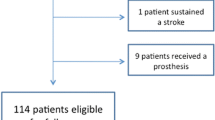Summery.
Introduction: The Humerus Fixator Plate is presented as a new implant for angle- and rotation-stable internal fixation for the operative treatment of proximal humerus fractures at the surgical neck. Methods: In an ongoing two-centre study, 47 patients were treated with the new implant. To date, 31 patients had clinical and radiological postoperative follow-up examinations with a mean interval of 10 months (range: 6–14 months). Results: In 46 patients (97.9 %), complete angle and rotational stability was achieved without limiting the range of motion or requiring immobilization. Good pain relief was obtained in 43 patients (91.5 %), and 3 patients (6.4 %) showed moderate pain relief following surgery. There was one implant failure. Utilizing the Constant-Raw score (without any correction factors), a mean result of 82.8 points (range: 46–100 points) was ascertained. The majority of the patients (87.1 %) achieved „excellent“ or „good“ clinical results. X-ray analysis revealed no non-union nor humerus head necrosis. In 4 cases (12.9 %), protrusion of a humerus head screw was observed which mandated removal of the implant. Conclusion: The first clinical investigations of the novel Humerus Fixator Plate are encouraging and provide essential advances in the treatment of unstable proximal humerus fractures.
Zusammenfassung.
Einleitung: Mit der Humerus-Fixateurplatte wird ein neues Implantat zur winkel- und rotationsstabilen Osteosynthese proximaler Humerusfrakturen im Collum chirurgicum vorgestellt. Methoden: Im Rahmen einer laufenden Bicenter-Studie wurde das neuentwickelte Implantat bei 47 Patienten eingesetzt. Mindestens 6 Monate postoperativ konnten bisher 31 Patienten nach einem mittleren postoperativen Intervall von 10 Monaten klinisch und radiologisch nachuntersucht wurden. Ergebnisse: Bei 46 Patienten (97,9 %) konnte eine primäre uneingeschränkte Übungsstabilität erzielt werden, wobei auf jegliche ruhigstellende Bandagen verzichtet wurde. 43 Patienten (91,5 %) gaben postoperativ eine deutliche Schmerzlinderung, 3 Patienten (6,4 %) gaben eine mäßige Schmerzlinderung an. Es war ein Implantatversagen zu verzeichnen. Im Constant-Score (Raw-Score ohne jegliche Korrekturfaktoren) fand sich ein Mittelwert von 82,8 Punkten (Spanne: 46–100 Punkte). Dabei erzielten 87,1 % der Patienten ein mit „gut“ bzw. „sehr gut“ zu bewertendes klinisches Resultat. Radiologisch fanden sich keine Humeruskopfnekrosen oder Pseudarthrosen. In 4 Fällen (12,9 %) fand sich eine Protrusion einer Oberarmkopfschraube, welche zu einer Entfernung des Implantats Anlass gab. Schlussfolgerung: Die mit der Humerus-Fixateurplatte erzielten klinischen Ergebnisse sind ermutigend und lassen eine deutliche Verbesserung bei der Versorgung dislozierter und instabiler proximaler Humerusfrakturen im Collum chirurgicum erwarten.
Similar content being viewed by others
Author information
Authors and Affiliations
Rights and permissions
About this article
Cite this article
Mückter, H., Herzog, L., Becker, M. et al. Die winkel- und rotationsstabile Osteosynthese proximaler Humerusfrakturen mit der Humerus-Fixateurplatte Erste klinische Erfahrungen mit einem neu entwickelten Spezialimplantat. Chirurg 72, 1327–1335 (2001). https://doi.org/10.1007/s001040170039
Issue Date:
DOI: https://doi.org/10.1007/s001040170039




